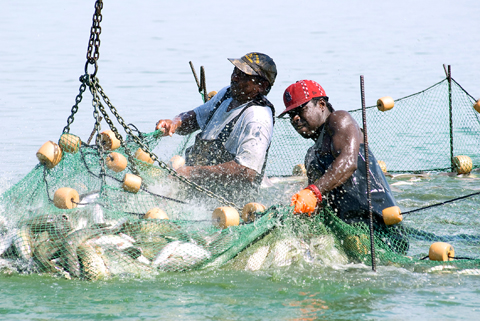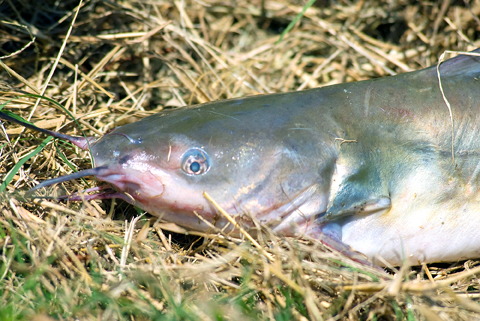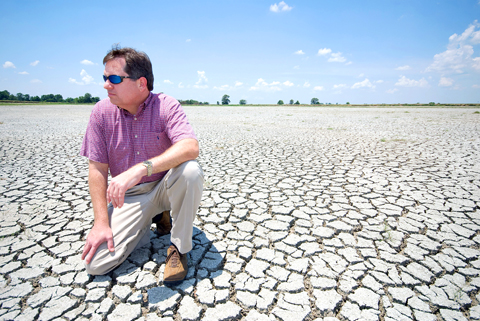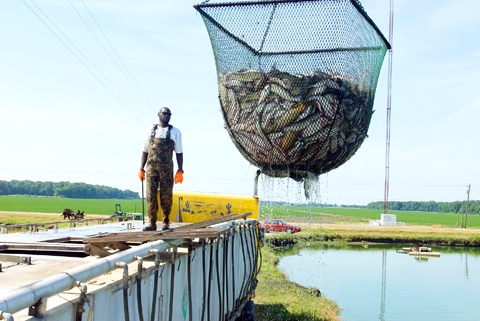Catfish farmers across the American south, unable to cope with the soaring cost of corn and soybean feed, are draining their ponds.
“It’s a dead business,” said John Dillard, who pioneered the commercial farming of catfish in the late 1960s. Last year Dillard & Co raised 11 million fish. Next year it will raise none. People can eat imported fish, Dillard said, just as they use imported oil.

PHOTO: NY TIMES NEWS SERVICE
As for his 55 employees? “Those jobs are gone.”
Corn and soybeans have nearly tripled in price in the last two years, for many reasons: harvest shortfalls, increasing demand by the Asian middle class, US government mandates for corn to produce ethanol and, most recently, the flooding in the Midwest.
This is creating a bonanza for corn and soybean farmers but is wreaking havoc on consumers, who are seeing price spikes in the grocery store and in restaurants. Hog and chicken producers as well as cattle ranchers, all of whom depend on grain for feed, are being severely squeezed.

PHOTO: NY TIMES NEWS SERVICE
Perhaps nowhere has the rise in crop prices caused more convulsions than in the Mississippi Delta, the hub of the US catfish industry. This is a hard-luck, poverty-plagued region, and raising catfish in artificial ponds was one of the few mainstays.
Then the economics went awry. Feed is now more than half the total cost of raising catfish, compared with a third of the cost of beef and pork production, according to a Mississippi state analysis. That makes catfish more vulnerable. But if the commodities continue to rocket up — and some analysts believe they will — other industries will fall victim as well.
Keith King, the president of Dillard & Co, calculates that for every US dollar the company spends raising its fish, it gets back only 75 cents when they go to market. “What’s happening to this industry is sad, but being sentimental won’t pay the light bill,” King said.

PHOTO: NY TIMES NEWS SERVICE
Dillard and other growers take their fish, still squirming, to Consolidated Catfish Producers in the hamlet of Isola, where workers run the machinery that slices them into filets. With fewer fish coming in, Consolidated Catfish is resorting to layoffs.
One hundred employees were let go in the last month, and an additional 200 will be cut soon. President Dick Stevens predicts that by the end of the year the company will have jobs for only 450, about half the number at its peak. That might not be enough to keep the plant open.
“The industry is going to implode,” Stevens said. He blamed the government’s ethanol mandates for making fuel compete with food for the harvest of the nation’s farmland. “Politicians were in a rush to do something, and it became a terrible snowball.”

PHOTO: NY TIMES NEWS SERVICE
Across the highway, one of the local feed mills, Producers Feed Co, has already shut down. The ripple effects have begun: Between the grain mill and the fish plant was Peter Bo’s Restaurant, locally celebrated for, naturally, its catfish. Hanging on the door is a “for rent” sign.
Some catfish producers recently switched to a feed based on corn gluten, a cheaper derivative of corn, to reduce their costs. But gluten transportation and prices were particularly hard hit by the Midwest floods.
“As sick as we were over what happened to the Iowa farmers, we were also sick over what was going to happen to us,” Stevens said.

PHOTO: NY TIMES NEWS SERVICE
It is a feeling echoed by others who depend on corn and soybeans.
In the spring, hog farmers thought they were past the worst. Export sales to China were strong. Corn appeared to level off. Some farmers sought an edge by reformulating pigs’ diets and reducing the weight at which they sent the animals to the packer.
“And then corn goes up another buck, and you’re back where you were,” said Dave Uttecht, a producer in Alpena, South Dakota, who raises 70,000 pigs a year.
“I’m a farmer. I’m used to peaks and valleys,” Uttecht said. “But this is like falling into the Grand Canyon.”
Smaller herds will eventually put a floor under hog prices, and there is already some liquidation going on. But in the short term, sending more hogs to market will increase the supply of pork and push prices down further. Every farmer is hoping his colleagues will liquidate first.
“We’re all waiting for someone else to blink,” Uttecht said.
Hog farmers at least have the advantage that bacon and pork chops are solidly rooted in American cuisine, and if you want either there is no replacement.
In this and many other ways, catfish farmers are not so lucky.
Catfish started out as a local delicacy, widely celebrated in the lore of the Deep South. Mark Twain saluted it in Life on the Mississippi. A character in Eudora Welty’s story The Wide Net says after stuffing himself, “There ain’t a thing better.”
Dillard, whose operation at its peak was one of the country’s five biggest catfish companies, came to the delta 50 years ago to farm cotton. He put in some catfish ponds a decade later almost on a whim. “I liked the way they tasted,” he said. “Fried.”
Other farmers had the same idea. At first the ponds were put on soil too dry for cotton. When they proved a better crop, they took over cotton ground, too. For a long time, everyone made money.
Times were too good, perhaps. In retrospect, the name probably should have been changed. Chilean sea bass would not have eclipsed the catfish if it were still known as the Patagonian toothfish, nor would orange roughy have become so esteemed as the slimehead.
“We didn’t focus on the market or on the product,” said Stevens, the processing factory president. “We’re the first culprits here.”
The industry’s decline accelerated when producers from Vietnam and China flooded the domestic market, putting a ceiling on prices.
Efforts by US producers to portray the imports as unclean and potentially unsafe did not work. The campaign did, however, achieve a measure of vindication last summer when the Food and Drug Administration announced broader import controls on Chinese seafood, including catfish, saying tests had shown the fish were contaminated with antimicrobial agents.
Rising feed prices were the last straw for Dillard & Co, which decided to close last January. Eighty of its 4-hectare to 8-hectare pools are empty already. An additional 170 will follow as soon as their fish are big enough to sell.
“It’s easy. You just pull the plug,” King said, surveying a pool that was nearly dry. Nearby, half a dozen men were running their nets through a pond, then hoisting the last of its catfish onto a truck.
“I’ve been doing this for 23 years,” said one of the workers, Craig Morgan. “I don’t know what I’ll do now. And there are a bunch of me’s out there.”
It is unclear what can replace catfish as easily as catfish replaced cotton. Attempts to make a tourist industry out of the fact that the delta was the birthplace of the blues are still embryonic.
“If we don’t do something, there will be nothing but tumbleweed here,” Jimmy Donahoo, a former catfish farmer, said. He, like others in the industry, thinks the producers should be supported by government subsidies, just like other farmers.
At Dillard & Co, they are not waiting for help.
“You focus your resources where you can maximize your profits,” King said. All the empty ponds will be planted with soybeans and corn, those two commodities for which there seems boundless appetite.

June 2 to June 8 Taiwan’s woodcutters believe that if they see even one speck of red in their cooked rice, no matter how small, an accident is going to happen. Peng Chin-tian (彭錦田) swears that this has proven to be true at every stop during his decades-long career in the logging industry. Along with mining, timber harvesting was once considered the most dangerous profession in Taiwan. Not only were mishaps common during all stages of processing, it was difficult to transport the injured to get medical treatment. Many died during the arduous journey. Peng recounts some of his accidents in

What does the Taiwan People’s Party (TPP) in the Huang Kuo-chang (黃國昌) era stand for? What sets it apart from their allies, the Chinese Nationalist Party (KMT)? With some shifts in tone and emphasis, the KMT’s stances have not changed significantly since the late 2000s and the era of former president Ma Ying-jeou (馬英九). The Democratic Progressive Party’s (DPP) current platform formed in the mid-2010s under the guidance of Tsai Ing-wen (蔡英文), and current President William Lai (賴清德) campaigned on continuity. Though their ideological stances may be a bit stale, they have the advantage of being broadly understood by the voters.

Artifacts found at archeological sites in France and Spain along the Bay of Biscay shoreline show that humans have been crafting tools from whale bones since more than 20,000 years ago, illustrating anew the resourcefulness of prehistoric people. The tools, primarily hunting implements such as projectile points, were fashioned from the bones of at least five species of large whales, the researchers said. Bones from sperm whales were the most abundant, followed by fin whales, gray whales, right or bowhead whales — two species indistinguishable with the analytical method used in the study — and blue whales. With seafaring capabilities by humans

In a high-rise office building in Taipei’s government district, the primary agency for maintaining links to Thailand’s 108 Yunnan villages — which are home to a population of around 200,000 descendants of the Chinese Nationalist Party (KMT) armies stranded in Thailand following the Chinese Civil War — is the Overseas Community Affairs Council (OCAC). Established in China in 1926, the OCAC was born of a mandate to support Chinese education, culture and economic development in far flung Chinese diaspora communities, which, especially in southeast Asia, had underwritten the military insurgencies against the Qing Dynasty that led to the founding of